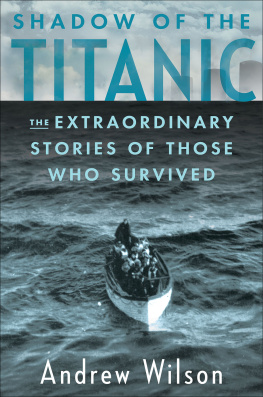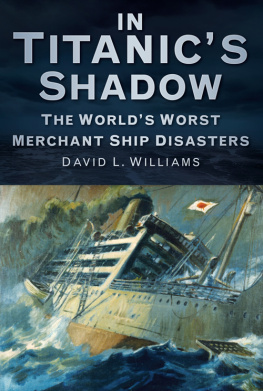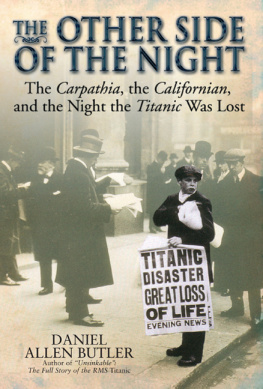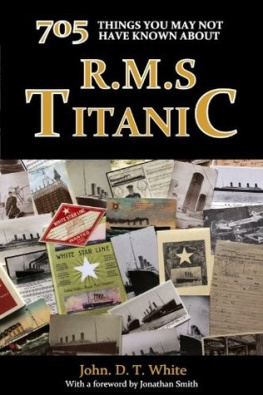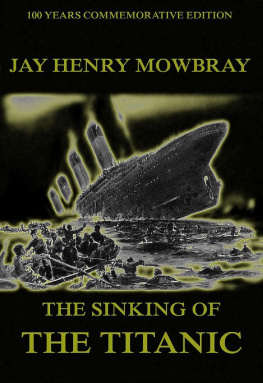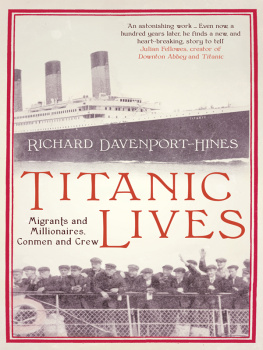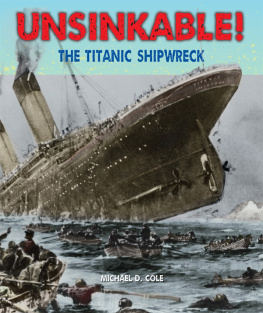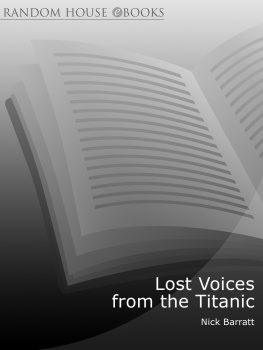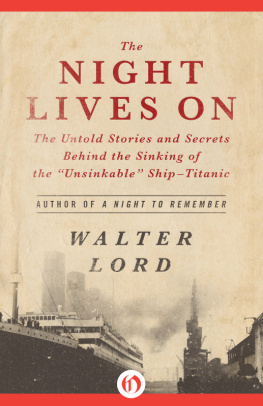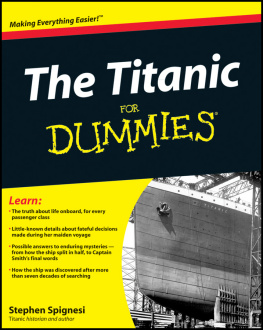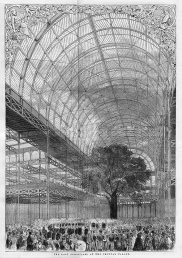The Crystal Palace, flagship symbol of Victorian confidence in progress and technology.
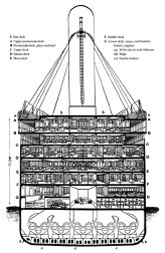
The Titanic (transverse section).
Credit: Titanic Historical Society, Indian Orchard, Mass.
Copyright 2012 by Skyhorse Publishing, Inc.
First published by Penguin Books 1980
Revised edition published by Penguin Books 1986
Copyright Wyn Craig Wade, 1979, 1986
All Rights Reserved. No part of this book may be reproduced in any manner without the express written consent of the publisher, except in the case of brief excerpts in critical reviews or articles. All inquiries should be addressed to Skyhorse Publishing, 307 West 36th Street, 11th Floor, New York, NY 10018.
Skyhorse Publishing books may be purchased in bulk at special discounts for sales promotion, corporate gifts, fund-raising, or educational purposes. Special editions can also be created to specifications. For details, contact the Special Sales Department, Skyhorse Publishing, 307 West 36th Street, 11th Floor, New York, NY 10018 or .
www.skyhorsepublishing.com
10 9 8 7 6 5 4 3 2 1
Library of Congress Cataloging-in-Publication Data available on file.
ISBN: 978-1-61608-432-5
Printed in the United States of America
Foreword
Years ago, I was motorcycling in Asia along the Himalayas, from Kathmandu to Bhutan through Sikkim, India. I was traveling with a group of Brits, who naturally required we stop for afternoon tea. In one remote village, with little more than a dirt road in and a dirt road out, we entered a humble establishment with only two tables and seating for no more than eight. On the wall I noticed a poster for James Camerons film, Titanic. I doubted that anyone in this small village could have possibly ever seen the ocean, yet they were familiar with the story of Titanic.
Titanic is not the shipwreck associated with the greatest loss of life, nor is it the deepest of shipwrecks. The events relating to the tragedy are reasonably well documented, and both Britain and the United States conducted formal inquiries into the sinking. Nevertheless, the story of the sinking of Titanic is something that people from around the world cannot help but be drawn to. Unequivocally, Titanic is the most famous shipwreck in the world.
For most of my adult life I have worked as a professional diver, and have been diving shipwrecks almost all of that time. As a free-swimming scuba and rebreather diver, I had visited some of the most legendary wrecks within reach of the technology of the day. I have had over 150 dives on the Andrea Doria, dived to the Lusitania located off the coast of Ireland, and been to the sister ship of Titanic, the Britannic, lost near the island of Kea in Greece.
The wrecks I had dived were hundreds of feet deep, while Titanic was thousands. The difference in depth was symbolic of the difference in cultural significance. Titanic was in a class far beyond anything I had ever experienced. It would be impossible for anyone who considered themselves a wreck diver not to dream about one day diving in a submersible to Titanic.
In 2005 I had the opportunity of a lifetime: to dive the Titanic. I was already working on programs for television with diving partner Richie Kohler and Lone Wolf Documentary Group producer Kirk Wolfinger. When I was approached with a program idea on Titanic, I immediately went to Kirk and Richie. We were going to Titanic! It was a business opportunity, but more than that it was a chance to visit the most famous shipwreck in the world. Given this opportunity, how could my life stay the same, and how could I not dream of perhaps contributing something to the cumulative knowledge of Titanic?
To prepare for our expedition, I needed to learn everything I could about Titanic, including her construction, her history, the sinking, and the legend. In the beginning, I probably knew as much as anyone with an interest in maritime history. As a young man, I had read the classic, A Night to Remember, by Walter Lord, and had seen the black-and-white film made from the book many times, at least as many times as I had seen Jim Camerons well-done blockbuster. I had seen several documentaries and read books relating to the discovery of the wreck of Titanic as well. I thought I already knew quite a bit about Titanic.
Then a friend recommended I read Wyn Craig Wades Titanic: End of a Dream, and told me that if I was to read only one book on Titanic, it should be this book. I thought this was rather presumptuous considering the book was out of print, more than twenty years old, and there were so many other recent writings with the benefit of all that modern explorers could contribute.
I approached reading End of a Dream as a work assignment, and certainly had to take into consideration when the book was written and the information available to the author at the time. I could not have been more surprised at what I found. I did not read anything prior to, or anything since, that was able to convey to the reader the meaning of Titanic.
I found Wyns writing to be engaging and endearing, but the thing that really made this book stand out was how it was able to translate the human emotions of the Titanic sinking into modern culture. Wyn was able to convey what Titanicand, more importantly, the sinking of Titanicmeant to the people of that time. If we cannot understand the impact of Titanic on the world of 1912, how can we possibly understand how Titanic integrates into our culture and thinking today?
Titanic was truly a community afloat, with everything you might find in a small city, including a government, social classes, and a sense of progress. As



